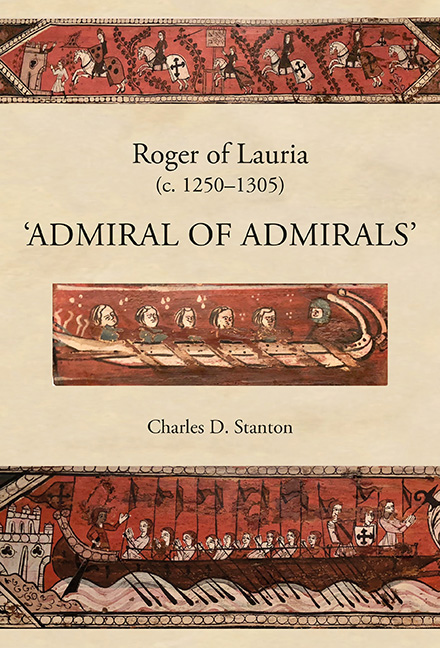Book contents
- Frontmatter
- Dedication
- Contents
- List of Illustrations
- Prologue
- 1 Battle of Benevento (26 February 1266)
- 2 A Calabrian Exile in the Court of Aragon (1262–1282)
- 3 Battle of Tagliacozzo (23 August 1268)
- 4 Aragonese Expansion (1229–1282)
- 5 Angevin Consolidation and Aggrandizement (1268–1282)
- 6 Revolt of the Vespers (30 March 1282)
- 7 Aragonese Intervention (August–October 1282)
- 8 Stalemate (November 1282–March 1283)
- 9 Admiral of Aragon (20 April 1283)
- 10 The Opposing Fleets (1282–1302)
- 11 Battle of Malta (8 June 1283)
- 12 Anjou's Dreams of Empire Dashed (June–November 1284)
- 13 France's Crusade Against Aragon (May–November 1285)
- 14 Battle of the Counts (23 June 1287)
- 15 Truces and Treaties (June 1287–November 1291)
- 16 Raid on Romania (Summer 1292)
- 17 Switching Sides (December 1293–April 1297)
- 18 Aragon's Invasion of Sicily at Anjou's Bidding (1298/1299)
- 19 Lauria's Last Great Campaign (Summer 1299–Spring 1300)
- 20 Endgame (Spring 1301–Summer 1302)
- Epilogue
- Bibliography
- Index
19 - Lauria's Last Great Campaign (Summer 1299–Spring 1300)
Published online by Cambridge University Press: 24 October 2019
- Frontmatter
- Dedication
- Contents
- List of Illustrations
- Prologue
- 1 Battle of Benevento (26 February 1266)
- 2 A Calabrian Exile in the Court of Aragon (1262–1282)
- 3 Battle of Tagliacozzo (23 August 1268)
- 4 Aragonese Expansion (1229–1282)
- 5 Angevin Consolidation and Aggrandizement (1268–1282)
- 6 Revolt of the Vespers (30 March 1282)
- 7 Aragonese Intervention (August–October 1282)
- 8 Stalemate (November 1282–March 1283)
- 9 Admiral of Aragon (20 April 1283)
- 10 The Opposing Fleets (1282–1302)
- 11 Battle of Malta (8 June 1283)
- 12 Anjou's Dreams of Empire Dashed (June–November 1284)
- 13 France's Crusade Against Aragon (May–November 1285)
- 14 Battle of the Counts (23 June 1287)
- 15 Truces and Treaties (June 1287–November 1291)
- 16 Raid on Romania (Summer 1292)
- 17 Switching Sides (December 1293–April 1297)
- 18 Aragon's Invasion of Sicily at Anjou's Bidding (1298/1299)
- 19 Lauria's Last Great Campaign (Summer 1299–Spring 1300)
- 20 Endgame (Spring 1301–Summer 1302)
- Epilogue
- Bibliography
- Index
Summary
DESPITE THE DEPARTURE OF KING JAMES of Aragon after the Battle of Capo d'Orlando, the Angevin reconquest of Sicily seemed to proceed apace, at first. Within three weeks of the victory, Pietro Salvacoscia, one of Frederick's most effective fleet commanders, went over to the Angevins and delivered the islands of Ischia, Capri and Procida to King Charles, who promptly made him protontino (vice admiral) – second only to Roger of Lauria. Roger, himself, quickly reclaimed several of his previous possessions in the Val Demone (northeastern Sicily): Castiglione, Rocella and Placa (Map 6). Niccolo Speciale insisted that Francavilla would have also returned to the admiral's allegiance had it not been dominated by the castle enfeoffed to Corrado Doria, his opposite number. Duke Robert of Calabria, whom his father (King Charles II) had appointed as his Vicar-General for the island on 24 July 1299, made slower progress. Marching towards the east coast, he stopped to besiege Randazzo, one of the most densely populated towns on Sicily at the time, but its fiercely independent citizenry steadfastly resisted. Robert eventually accepted Roger's advice and moved on to more fruitful, obliging objectives on the south side of Mount Etna, with Catania as the ultimate objective.
The Angevin army was, thus, able to occupy with ease Adernò (modern Adrano), on the southwestern foot of the volcano. Robert soon laid siege to Paternò, a city a mere 14 miles (22.5 km) northwest of Catania. The local lord, Manfred Maletta, surrendered it on the second day. Maletta was then induced to also give up Buccheri, another small city under his control in the Val di Noto (southeastern Sicily) about 30 miles (50 km) west of Syracuse (Map 6). From there, Roger took a detachment of troops to nearby Vizzini, which he cajoled into submission through the persuasion (presumably at sword point) of a certain Giovanni Callaro, a favourite son of the city whom Lauria had captured at Capo d'Orlando. Afterwards, Roger rejoined Robert at Palagonia and the two of them marched south beyond Vizzini to Chiaramonte, about 10 miles (16 km) north of Ragusa. Chiaramonte was a fief of the eponymous noble family, one of the most powerful on Sicily and staunchly loyal to Frederick, so its citizens refused to yield without a fight. It was a terrible mistake, for which most of them paid with their lives in ghastly fashion.
- Type
- Chapter
- Information
- Roger of Lauria (c.1250–1305)‘Admiral of Admirals’, pp. 271 - 288Publisher: Boydell & BrewerPrint publication year: 2019

